1 – 11 JUNE 2024
By Dominic Rollinson
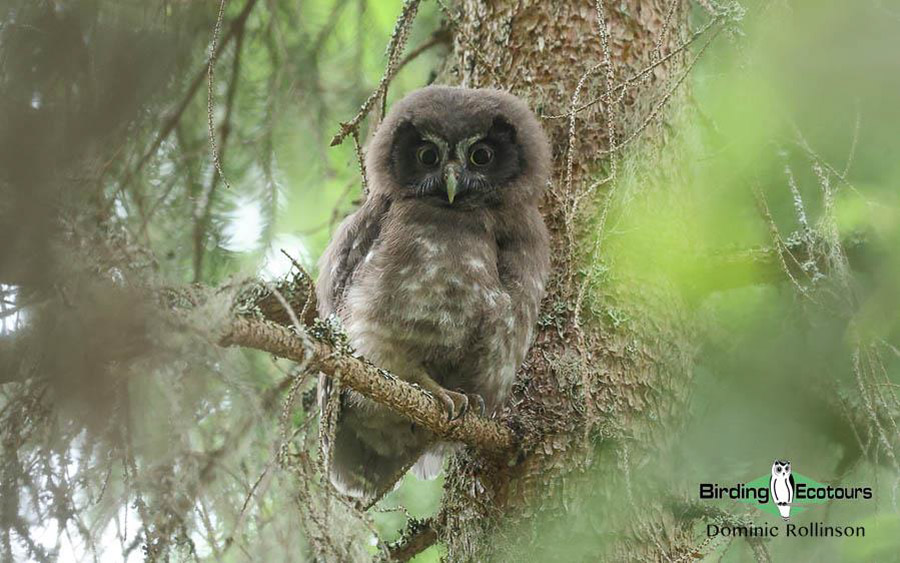
This juvenile Boreal (Tengmalm’s) Owl was an early tour highlight.
Overview
Our Finland and Norway: Taiga and Tundra birding tour was timed to coincide with the breeding season for a range of exciting Scandinavian species, with owls, grouse, breeding shorebirds and seabirds high on the agenda. With this trip taking place in early summer, it meant that we had 24 hours of daylight, and so, if we had the energy, we were able to bird late into the evening.
This trip took us from the vast taiga forests (also known as boreal forests) of central Finland north into Norway where we enjoyed time in the tundra of the Arctic Circle, also spending time birding on seabird breeding islands and along dramatic fjords. We started our Scandinavian adventure in Oulu (Finland) where we spent a few days birding in taiga forests and wetlands. Some of the highlights in this area included, most importantly, Eurasian Pygmy, Boreal and Ural Owls, as well as Black, Eurasian Three-toed, Lesser Spotted and Grey-headed Woodpeckers and an assortment of waterfowl such as Whooper Swan, Garganey, Northern Pintail, Common Scoter, Smew and Red-breasted and Common Mergansers.
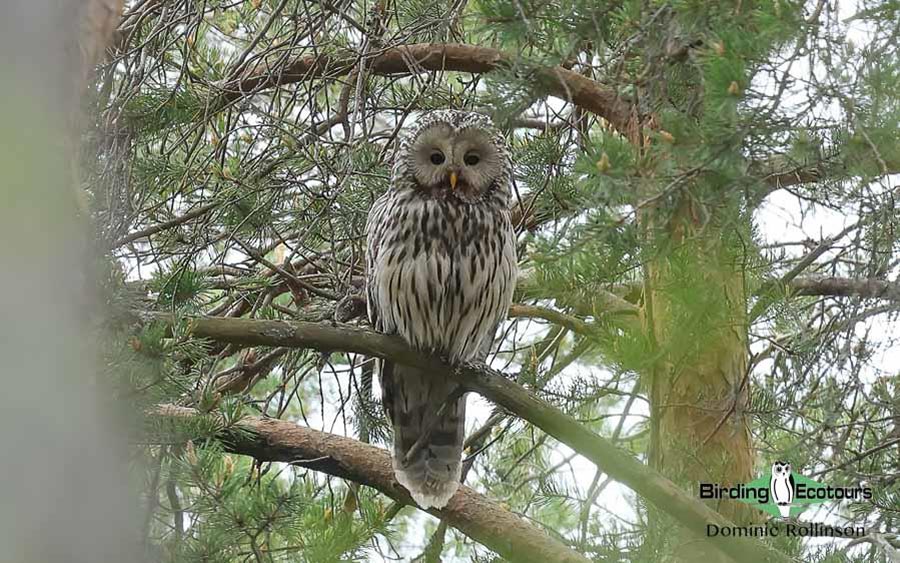
This huge Ural Owl was seen well around Oulu.
We then moved north to the Kuusamo area where further taiga forest birding was enjoyed. Various grouse species were our primary targets in this area, and we managed to find Black and Hazel Grouse and Western Capercaillie, including a memorable encounter with a displaying male capercaillie. Other big targets here included Northern Hawk-Owl, Grey-headed Chickadee (Siberian Tit), Siberian Jay and Red-flanked Bluetail, which we all saw well.
Our journey continued northwards as we crossed into Norway and enjoyed a few days birding in the cold Arctic tundra, which offered a very different mix of bird species. Highlights during our time here included Willow and Rock Ptarmigans, Rough-legged Buzzard, Lapland Longspur, Arctic Redpoll and several species of breeding waders (shorebirds).
For our final few days of the tour, we moved to the picturesque Varangerfjord where we visited the seabird breeding island of Hornøya, enjoying point-blank views of impressive numbers of European Shag, Thick-billed and Common Murres, Razorbill and Atlantic Puffin. Further exploration of the tundra here delivered an Arctic Fox which was another major trip highlight. The tour then ended in Kirkenes after a successful and enjoyable eleven days of Scandinavian birding.
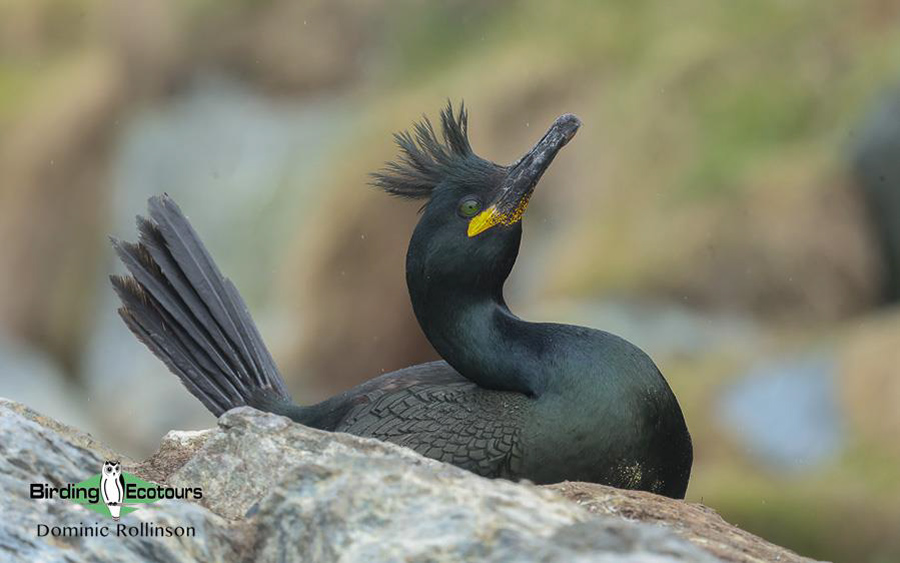
We could not have asked for better looks of European Shag on Hornøya island.
Unfortunately, we ended up missing some of the hoped-for owl species; with a pair of Great Grey Owls having abandoned their nest a couple weeks before our trip and Snowy Owl proving elusive. Finding owls in Scandinavia is very much reliant on vole abundance and, unfortunately, the summer of 2024 was not a particularly impressive vole year, which meant certain owl species were in lower densities this year.
Many thanks to our expert local guide and driver, Pirita, whose intricate knowledge of the area and supreme birding skills ensured we ended with an impressive bird list of 185 species. Thanks too to the tour participants, Murray, Sandra, Janette and Michael for helping make the trip the success it was.
Detailed Report
Day 1, 1st June 2024. Birding the Oulu area
With all tour participants having arrived the day before, we decided to make an earlier start to our birding. A prebreakfast walk around our well-positioned birding lodge, right on the edge of a bay of the Baltic Sea, started our list off nicely with Gadwall, Red-breasted Merganser, Common Goldeneye, Eurasian Curlew, Spotted Flycatcher and Common Rosefinch all seen nicely.
We met Pirita after breakfast and then loaded up into the van. Our first couple birding stops produced more good wetland and wetland edge species such as Eurasian Wigeon, Tufted Duck, Smew, Common Scoter and Ruff, with European Pied Flycatcher, Lesser Whitethroat and Garden Warbler seen in the nearby treed areas.
It was then time to target some owls and we went to our first Eurasian Pygmy Owl nest box, where the resident pair were not very cooperative, nevertheless, we did find European Honey Buzzard, Eurasian Sparrowhawk (which almost took our heads off as it shot by, chasing a bird), and Coal, Willow and Great Tits. The next pygmy owl nest site proved much more rewarding as, soon after arriving, we noticed an adult Eurasian Pygmy Owl watching us quietly from not too far above us. We enjoyed watching this tiny predator for a while, before pulling ourselves away to move onto our next birding spot.
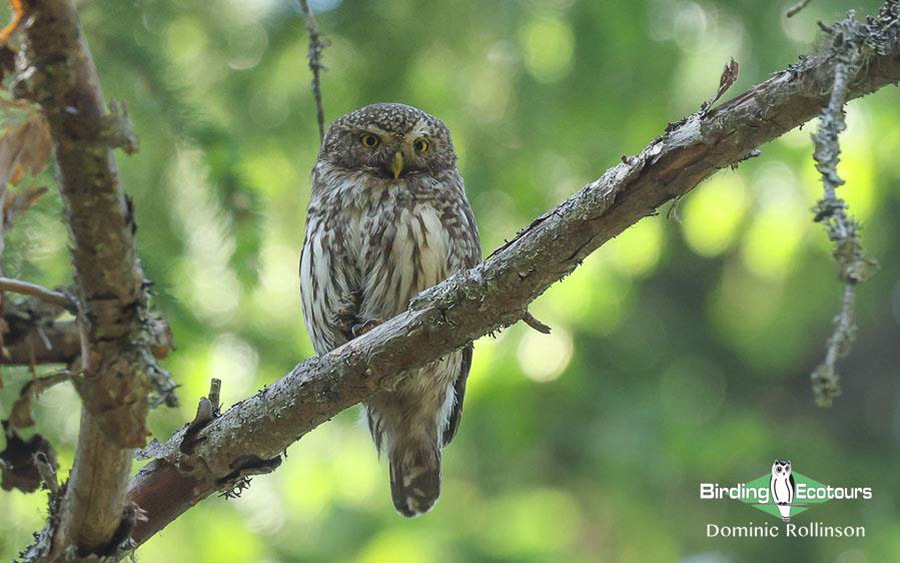
Eurasian Pygmy Owl was seen well near Oulu.
Next up was a Black Woodpecker nest site, which took a while to show, but eventually we had lovely looks, as one of the adults came back to visit the breeding hole. Other good birds seen while waiting for the woodpecker included Great Spotted Woodpecker, Spotted Flycatcher and Eurasian Chaffinch.
We ended the day with another small owl species, this being a juvenile Boreal (Tengmalm’s) Owl, close to its nest site. We enjoyed watching this cute owl species for a while and then decided to move on and bird some other woods and fields nearby, which were mostly quiet. A small pond nearby held a very showy pair of Horned (Slavonian) Grebes and ended a highly productive first day of birding in Finland.
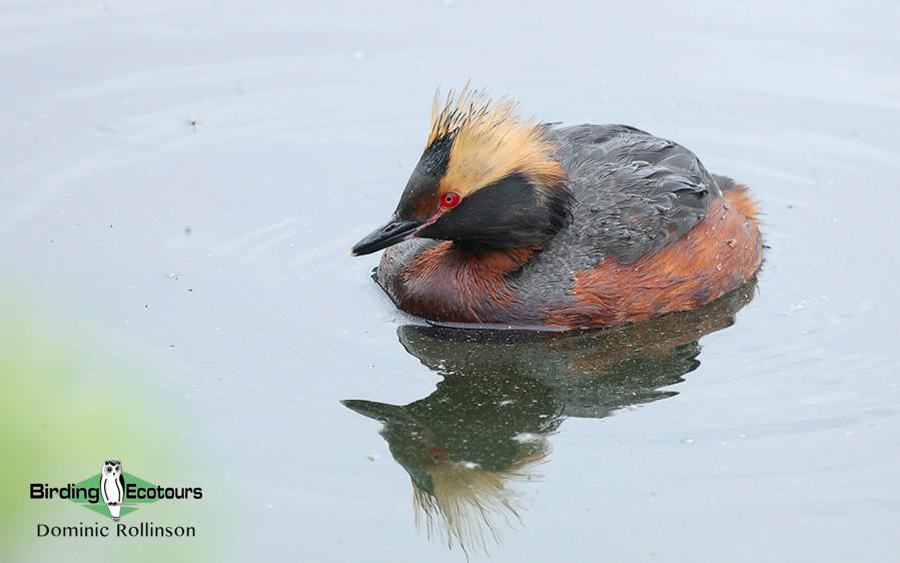
This Horned Grebe was another highlight of our first day.
Day 2, 2nd June 2024. Birding Oulu and surrounds
Another pre-breakfast birding walk from our hotel provided sightings of Garganey, Red-necked Grebe, Black-tailed Godwit, displaying Common Snipe, Western Marsh Harrier and European Pied Flycatcher.
After breakfast we loaded up into our van, with the first stop at a nearby lake adding lovely views of Common Scoter, with small numbers of Little Gulls seen feeding low over the water. In the surrounding area we had displaying Eurasian Skylarks and singing Yellowhammers while, a little further afield, a roadside stop added Common Crane, Whinchat, Common Whitethroat, Common Linnet and our first Redwing of the trip.
Our next stop was Virkkula birdwatching tower, on the shores of Liminka Bay, which was full of birds. Here we found a good selection of waterbirds, including Mute Swan, Garganey, Northern Shoveler, Eurasian Teal, Common and Spotted Redshanks, Common Greenshank, Common Gull, Common Tern, Whinchat and Meadow Pipit. We enjoyed a hearty lunch in the visitor center and then took a walk around the impressive bird exhibit, where we prepped on some of the birds we were hoping to see on this trip.
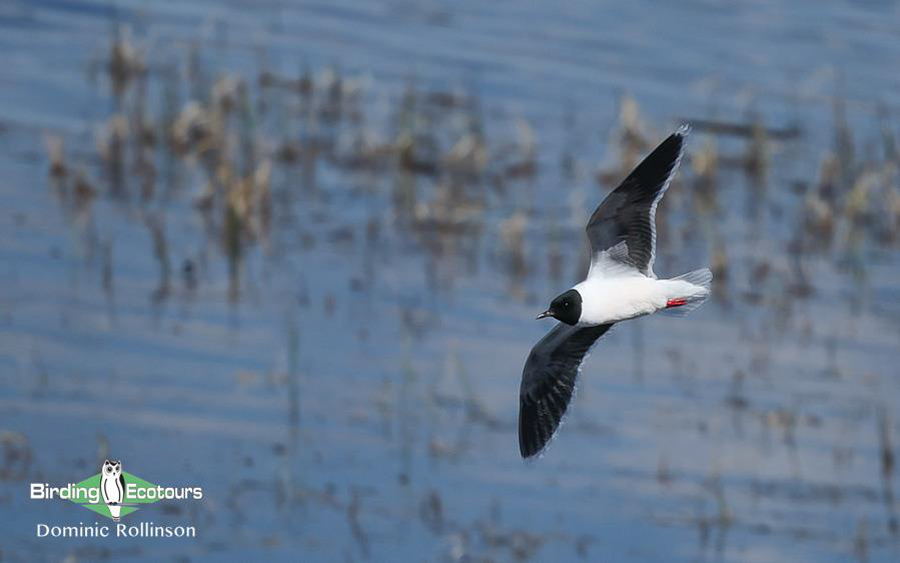
Attractive Little Gulls were seen on lakes around Oulu.
Later that afternoon we visited a nest site of a pair of massive Urals Owls. It didn’t take too long before we spotted the female guarding her nest and, with some careful manoeuvring, we positioned ourselves to enjoy unobstructed views from a safe distance. This was a highly memorable experience as we enjoyed prolonged scope views, with a Rustic Bunting heard calling nearby, which unfortunately would not show itself. On our way back to our hotel, we made a quick stop at a small wetland where we heard the distant boom of a Eurasian Bittern, before calling it a day.
Day 3, 3rd June 2024. Further Oulu birding
Our pre-breakfast birding walk did not produce too much different from the previous two mornings, although a small flock of Common Cranes were a nice addition. Over breakfast, Michael reported that he had seen a bird he was pretty certain was an Arctic Warbler and so, after breakfast, we visited a particular patch of trees. The warbler duly obliged, and we were able to add this species to our list. This was likely an early (and slightly out-of-place) migrant, heading towards its breeding grounds further north.
We then moved a little north of Oulu, where we targeted Eurasian Wryneck, which did not take long to show itself. Sadly, the calling Goldcrests would not show for us. We then moved around the corner to an industrial park where, right on cue, we heard the song of Terek Sandpiper, which landed on its well-used perch and gave us prolonged scope views. It seemed a bizarre site for this wader to breed, however, they had used this site for the previous few years and were seemingly quite happy here.
After the excitement of the Terek Sandpiper, we moved to a nearby spot of dense woodlands, where we spent the next couple of hours birding and eking out a few warblers and other cryptic species. We had to work for all our sightings here but eventually we added Greenish and Garden Warblers, Red-breasted Flycatcher and a showy Northern Wheatear. We tried a nearby stakeout for Thrush Nightingale and, despite hearing it singing, we could not lay eyes on this skulker. Another patch of woodlands held a trio of Eurasian Treecreepers and a very showy pair of Wood Warblers.
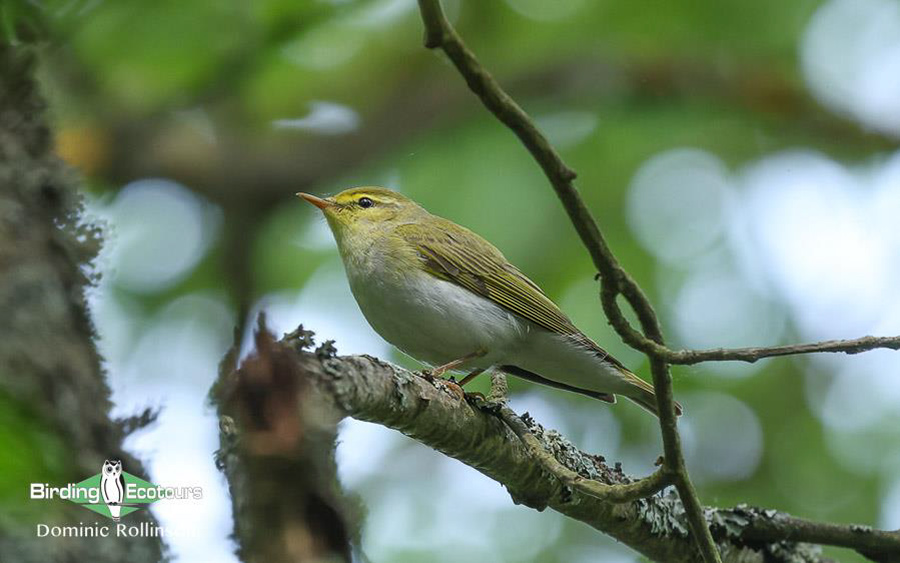
Wood Warblers brightened up the woodlands around Oulu.
After lunch, we moved to a mature patch of taiga forest, where we were after a few woodpecker species. Eurasian Three-toed Woodpecker showed easily in its nest hole, with Lesser Spotted Woodpecker proving easy too. Grey-headed Woodpecker proved tricky though and, after trying for a while (and fighting off the worst mosquitoes of the trip), we decided to pack it in and try again the following morning, on our way out of Oulu.
The day ended with a brief Eurasian Woodcock flyby, after having narrowly missing this species on a few occasions over the last few days.
Day 4, 4th June 2024. Oulu birding and transfer to Kuusamo
We weren’t in any particular rush to leave the Oulu area this morning and so we birded some farmlands, which held Eurasian Tree Sparrow, Ortolan Bunting and Eurasian Skylark. We then decided to give the Grey-headed Woodpecker another shot, which thankfully obliged today after a fairly short wait.
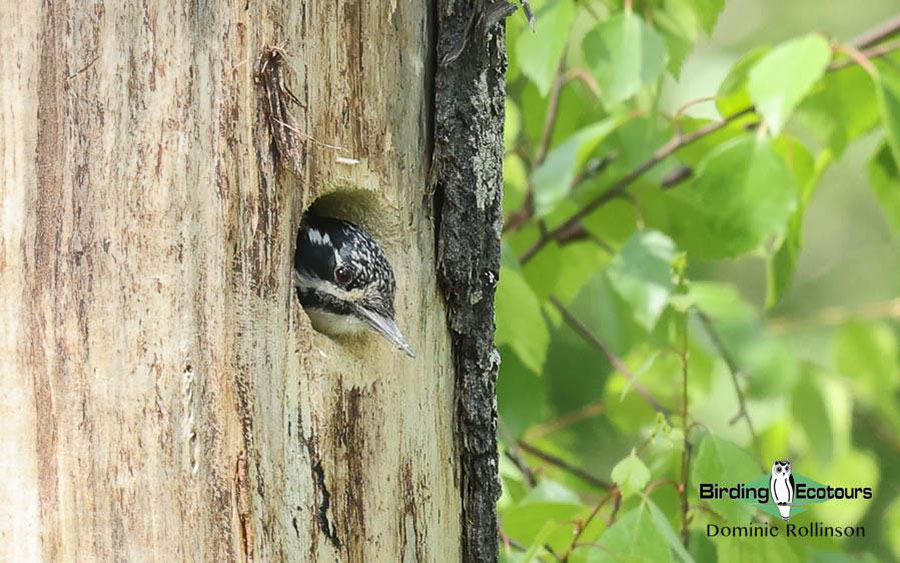
Woodpeckers, such as this Eurasian Three-toed Woodpeckers, were another tour highlight.
The drive for today would only take us around three hours, so we decided to bird along the way, making a series of short stops for certain species. As we made our way northwest out of Oulu we stopped off in some mature taiga forest, where we soon found Crested Tit and Tree Pipit,while a bog further north added Taiga Bean Goose, Common Crane and Western Yellow Wagtail. A small lake held Little Gull, Western Yellow Wagtail and our first Black-throated Loon of the tour.
Before arriving at our hotel in Kuusamo we made one last stop for the day, adding an obliging Grey-headed Chickadee (Siberian Tit), a big tour target. This was a lifer for Michael and was number 4000 for his world list; that evening we enjoyed champagne celebrations!
Day 5, 5th June 2024. Taiga forest birding around Kuusamo
We didn’t let the celebrations go on too late last night, since we had a 3:30 am departure to go look for lekking grouse! An early start was required because the grouse stop lekking when the day gets too hot. We arrived on site in an area where Western Capercaillie regularly lek and, within a few minutes, we spotted a male and watched him strut around, seemingly unphased by our presence. Male capercaillies can be extremely aggressive at their leks, thankfully, this bird didn’t bother us!
After an incredible 30 minutes or so with the capercaillie, we moved on to go look for Black Grouse. , Unfortunately all their regular lek sites were empty and we decided it was probably a little too warm for them. Despite this, we had some wonderful birding this morning and were delighted to find Velvet Scoter, Hazel Grouse (brief flight views), Red Crossbill, Taiga Bean Goose (improved views), Common Crane, Common Snipe, Eurasian Siskin and another two Western Capercaillies! Good numbers of Mountain Hares were seen this morning too!
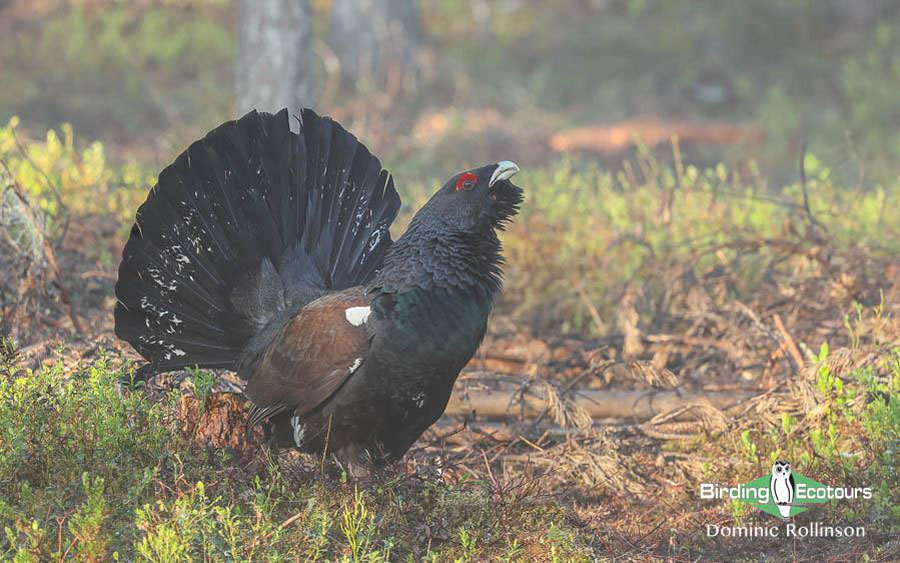
It was wonderful to watch this lekking male Western Capercaillie near Kuusamo.
We enjoyed our breakfast (always tastes better with capercaillie in the bag!) and then took some time off after our very early start. Later that morning we loaded up into the van and birded some nearby wetlands for the rest of the morning. The birding was a little slower (than the early morning outing at least) but we did manage to find Red-necked Grebe, Little Gull, Arctic Tern, Wood Sandpiper, Black-throated Loon, Sand Martin and a Little Bunting in some nearby scrub. We were excited to find another male Western Capercaillie quietly walking in the undergrowth; a nice catch-up bird for Janette and Sandra who had not joined in the early morning.
After our lunch we took a drive east towards the Russian border where we managed to find Merlin, Black Kite, Northern Raven (a very distant bird), Brambling, and Mistle Thrush. Another good sighting this afternoon was brief looks at an Ermine (Stoat). We ended a little earlier this afternoon as we had another early start the next morning to target lekking Black Grouse!
Day 6, 6th June 2024. Kuusamo birding
Our alarms were again set early and we left our hotel at 3:30 am and made our way towards some classic Black Grouse lekking sites. We arrived at the first site and immediately spotted as many as nine male Black Grouse which were busy defending prime lekking spots. We enjoyed watching them through the scope before we moved on to look for more targets. One of the major highlights (and surprises) of the morning was a sighting of a pair of Northern Hawk-Owls which we noticed flying across the road, carrying prey. Pirita suspected there was likely a nest nearby and it didn’t take long before we spotted three chicks sat in a tree. In the same area as the hawk-owls, we saw another group of lekking Black Grouse. After the excitement of the hawk-owls we made our way to a forested hill near Oulanka National Park, where we saw a few singing male Red-flanked Bluetails,as well as Goldcrest, Eurasian Bullfinch, Brambling, Eurasian Siskin and improved our views of Hazel Grouse.
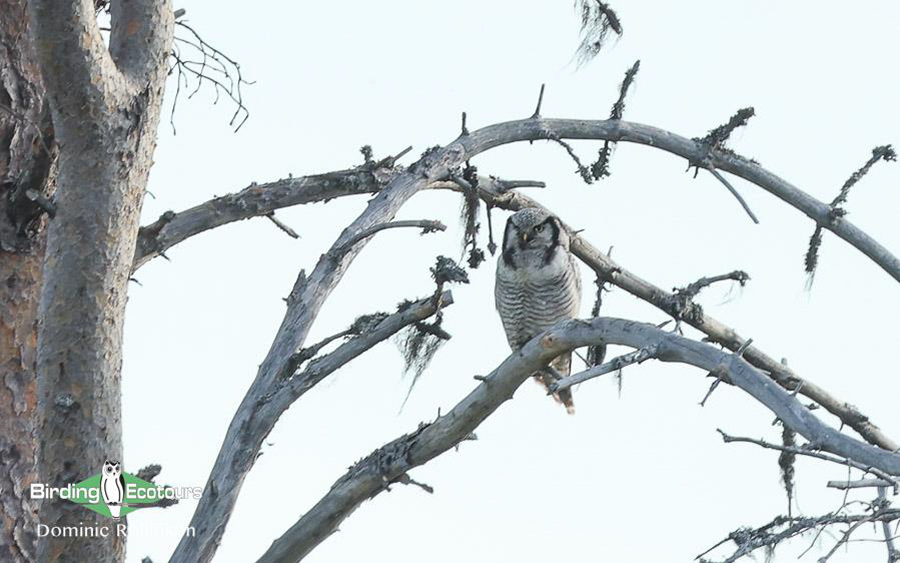
This Northern Hawk-Owl was a lovely find around Kuusamo.
It was another enjoyable breakfast (this time revelling in our hawk-owl sighting) and then we had some more time off to catch up on some sleep. We then loaded up into the van again. We spent most of the rest of the day birding in and around Oulanka National Park. A quick stop for dippers proved a fun one as we found a couple begging juvenile White-throated Dippers and a Grey Wagtail. We did a riverside walk in the hopes of finding Parrot Crossbill but had to settle with Spotted Flycatcher, White Wagtail and Eurasian Siskin, before we enjoyed a tasty lunch.
We were still missing Siberian Jay and so decided to work some conifer forests on the drive back to Kuusamo. The forest was quiet but after a while we heard them calling and got some nice looks at another important trip target. Before getting back into Kuusamo, we stopped at the Northern Hawk-Owl site, where we again enjoyed prolonged views; another nice catch-up bird for Sandra and Janette.
Day 7, 7th June 2024. Transfer to Ivalo
Today was mostly a travel day, as we made our way north to Ivalo in northern Finland. Before we hit the road properly, we birded some taiga woodlands where we again saw Siberian Jay. We then started the journey north and enjoyed a traditional shot of liqueur as we crossed the Arctic Circle. In the late afternoon we birded some moorland on the slopes of Saariselka where, after a long search, we found Eurasian Dotterel which provided fantastic views. Other birds seen during our search included European Golden Plover, Common Ringed Plover and Meadow Pipit.
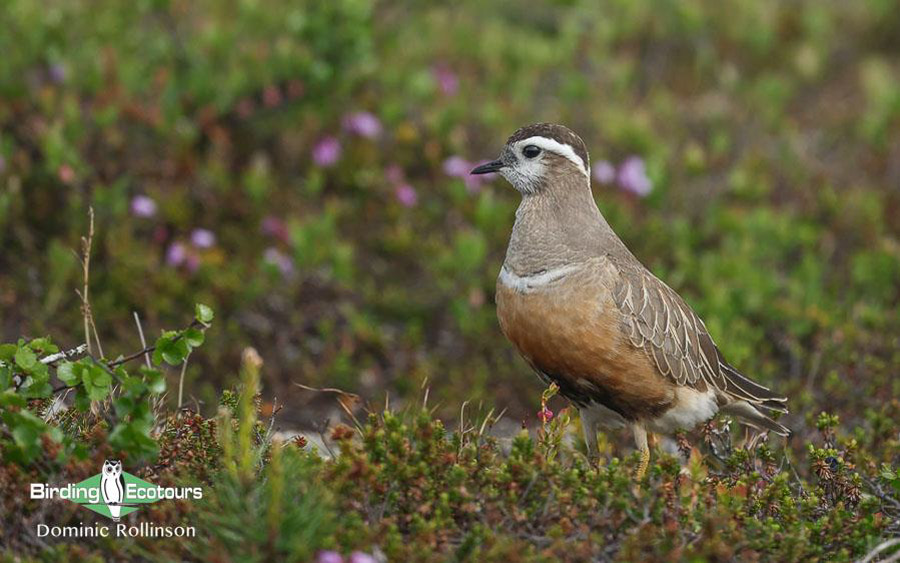
This confiding Eurasian Dotterel put on a wonderful show for us.
Day 8, 8th June 2024. Transfer to Norway and tundra birding
Before leaving the taiga forests near Ivalo we had another look for Rustic Bunting but had to settle for a showy Little Bunting. We then visited some bird feeders near Kaamenen, which were alive with birds. Here, we had point-blank views of Pine Grosbeak, Brambling, Eurasian Bullfinch, European Greenfinch and Common Redpoll, as we enjoyed a hot drink and a bite to eat. A couple showy Eurasian Red Squirrels were fun to watch here too.
As we continued to make our way north the vegetation began to thin out and a couple roadside stops added Bluethroat, Northern Raven and Eurasian Whimbrel. We stopped at a bog where Broad-billed Sandpipers are known to breed but as we stopped, the heavens unfortunately opened, and we decided to retreat to the vehicle.
After lunch we crossed into Norway and birded alongside the Tana River and the Tana River Delta. The birding here was excellent and we found many new birds, such as Common Eider, Bar-tailed Godwit, Temminck’s Stint, Dunlin and Parasitic Jaeger.
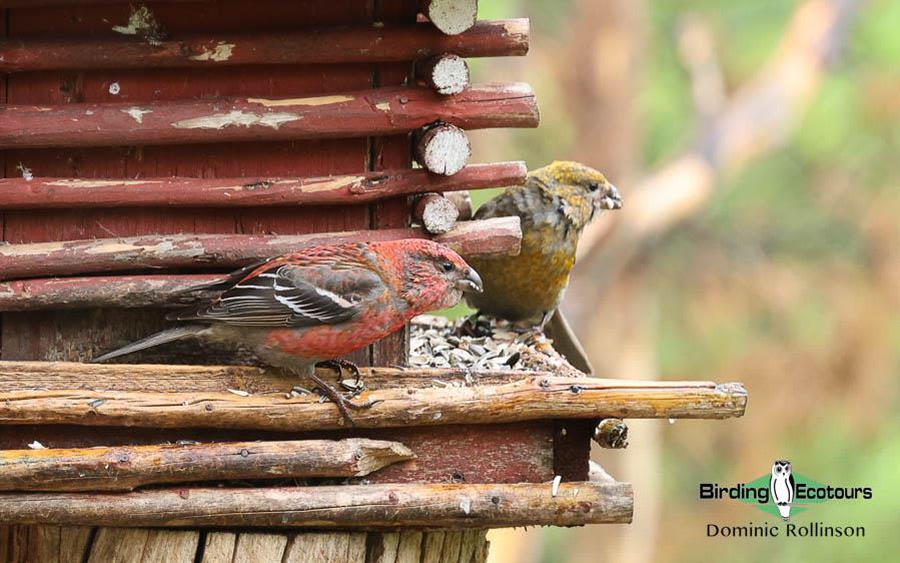
Pine Grosbeak were seen at bird feeders near Kaamenen.
For most of the remainder of the afternoon, we slowly made our way through the Arctic tundra of the highlands, which again proved incredibly productive (although very chilly)! We enjoyed watching lekking Ruffs, displaying Temminck’s Stints and Willow and Rock Ptarmigans and small flocks of Arctic Redpolls. We made a stop at a roadside lake which held Eurasian Teal, Long-tailed Duck, Common Merganser, Greater Scaup, Long-tailed Jaeger, Red-throated Loon, European Golden Plover, Common Snipe, Red-necked Phalarope and more lekking Ruffs.
After a long day, we eventually arrived in Batsfjord, where we checked in and enjoyed our dinner. After dinner we took a drive to an area where a Snowy Owl had been seen a few days prior. Despite a good search we could not locate the owl and had to settle for decent looks at a Rough-legged Buzzard.
Day 9, 9th June 2024. Tundra birding and transfer to Varangerfjord
After breakfast we packed the van and made our way back through the highlands, where we were still missing a few tundra specials. Ring Ouzel, Horned Lark, Snow Bunting and Lapland Longspur did not take too long to find, with more Rock and Willow Ptarmigans, Bluethroat and Long-tailed Jaeger again seen in the area.
We then made our way back to the coast and followed the coastline as we headed east. Our picnic lunch stop was a picturesque one as we sat watching waders such as Little Stints, Eurasian Oystercatchers and Bar-tailed Godwits.
We continued to make our way along the coastline and a number of birding stops further added Tundra Bean Goose, Great Black-backed Gull, Ruddy Turnstone, Red Knot, Curlew and Purple Sandpipers and Common Redshank.
Large flocks of Common Eider were carefully scanned and eventually we managed to pick out both Steller’s and King Eiders – two major targets on this tour. Within these flocks we also picked out Common Scoter, Long-tailed Duck and Common and Red-breasted Mergansers.
In the late afternoon we made our way onto the island of Vardø (via the underwater tunnel) and decided to take it easy for the remainder of the afternoon .
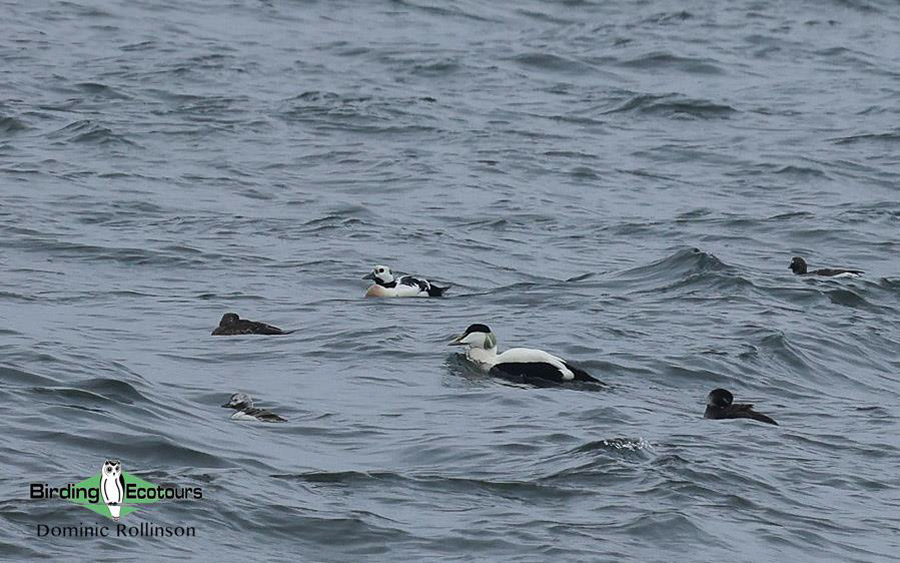
After a bit of a search we eventually found Steller’s Eider in amongst the Common Eider flocks.
Day 10, 10th June 2024. Hornøya and Vardø birding
Today was the final full day of the tour and we decided to have a more leisurely morning, with a stroll around the town. Black-legged Kittiwakes were breeding on most of the buildings around town, while a quiet secluded bay held a stunning Yellow-billed Loon. We also found a few Red-throated Pipits in some nearby fields.
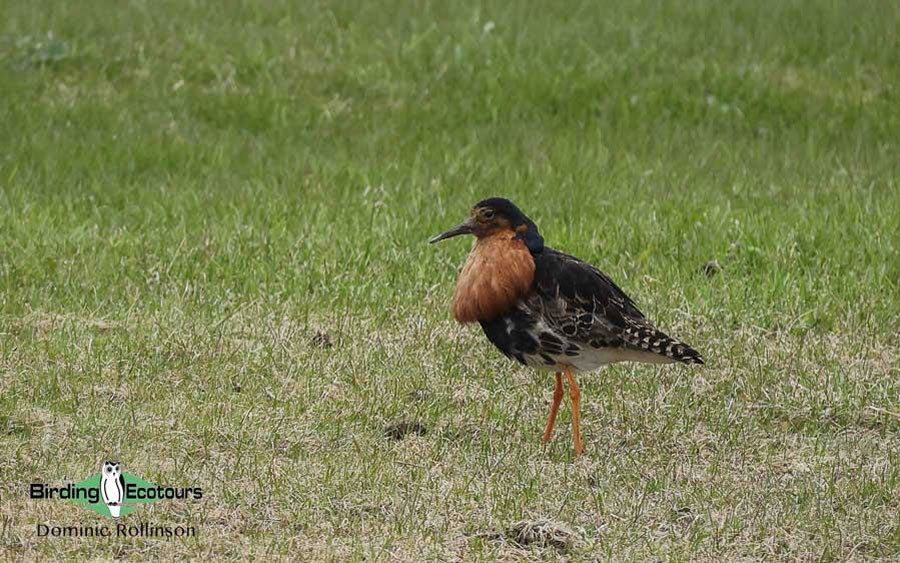
Lekking male Ruff of all varieties were widespread in Finland and Norway.
After breakfast we took the short boat trip to Hornøya island, which is packed full of breeding seabirds. We then spent an enjoyable couple of hours wandering in amongst breeding European Shags, Thick-billed and Common Murres, Atlantic Puffins, Razorbills and Black-legged Kittiwakes. Barnacle Geese also made a couple flybys.
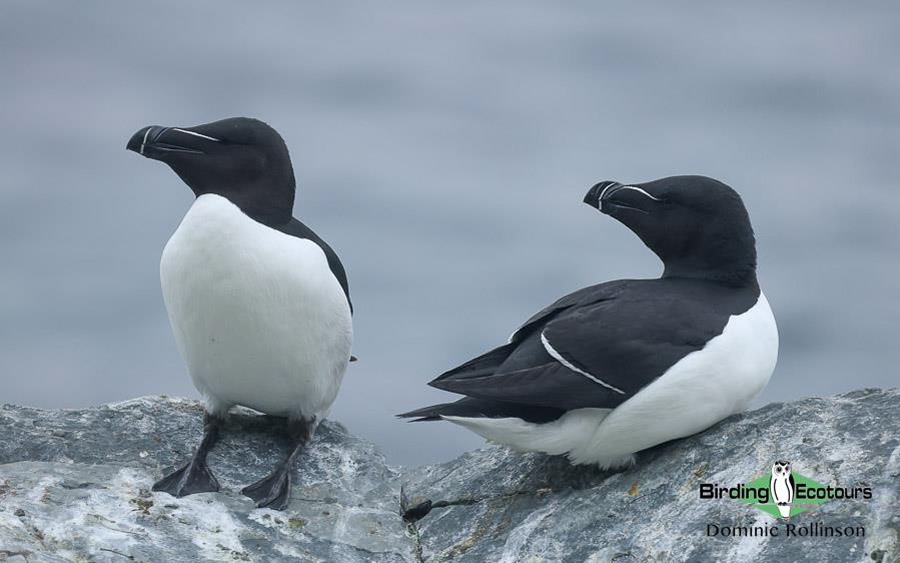
Razorbills were seen well on Hornøya island.
After a wonderful fish lunch we took a drive back through the tunnel and onto the mainland, which was a little on the quiet side, although did produce many White-tailed Eagle sightings. The highlight of the afternoon was a single Arctic Fox.
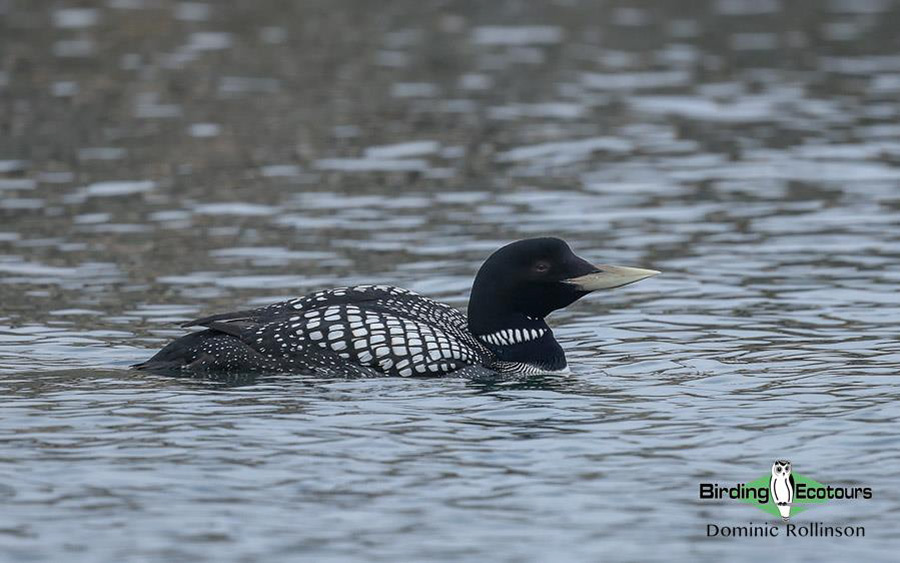
This Yellow-billed Loon was particularly confiding on Vardo.
Day 11, 11th June 2024. Transfer to Kirkenes and departure
With late morning flights scheduled, we had to get moving early and, thankfully, the drive to Kirkenes was uneventful, with just a few White-tailed Eagles being the most noteworthy species. The tour ended at Kirkenes Airport, where we said our goodbyes after a fantastic eleven days of birding in Finland and Norway.
Bird List – Following IOC December 2023
Birds ‘heard only’ are marked with (H) after the common name, all other species were seen both by clients and guide. The following notation after species names is used to show conservation status following IUCN List of Threatened Species. VU = Vulnerable.
| Common name | Scientific name |
| Ducks, Geese, Swans (Anatidae) | |
| Barnacle Goose | Branta leucopsis |
| Greylag Goose | Anser anser |
| Taiga Bean Goose | Anser fabalis |
| Tundra Bean Goose | Anser serrirostris |
| Mute Swan | Cygnus olor |
| Whooper Swan | Cygnus cygnus |
| Common Shelduck | Tadorna tadorna |
| Garganey | Spatula querquedula |
| Northern Shoveler | Spatula clypeata |
| Gadwall | Mareca strepera |
| Eurasian Wigeon | Mareca penelope |
| Mallard | Anas platyrhynchos |
| Northern Pintail | Anas acuta |
| Eurasian Teal | Anas crecca |
| Tufted Duck | Aythya fuligula |
| Greater Scaup | Aythya marila |
| Steller’s Eider – VU | Polysticta stelleri |
| King Eider | Somateria spectabilis |
| Common Eider | Somateria mollissima |
| Velvet Scoter – VU | Melanitta fusca |
| Common Scoter | Melanitta nigra |
| Long-tailed Duck – VU | Clangula hyemalis |
| Common Goldeneye | Bucephala clangula |
| Smew | Mergellus albellus |
| Common Merganser | Mergus merganser |
| Red-breasted Merganser | Mergus serrator |
| Pheasants & Allies (Phasianidae) | |
| Hazel Grouse | Tetrastes bonasia |
| Willow Ptarmigan | Lagopus lagopus |
| Rock Ptarmigan | Lagopus muta |
| Western Capercaillie | Tetrao urogallus |
| Black Grouse | Lyrurus tetrix |
| Common Pheasant | Phasianus colchicus |
| Swifts (Apodidae) | |
| Common Swift | Apus apus |
| Cuckoos (Cuculidae) | |
| Common Cuckoo | Cuculus canorus |
| Pigeons, Doves (Columbidae) | |
| Rock Dove | Columba livia |
| Common Wood Pigeon | Columba palumbus |
| Eurasian Collared Dove | Streptopelia decaocto |
| Cranes (Gruidae) | |
| Common Crane | Grus grus |
| Grebes (Podicipedidae) | |
| Red-necked Grebe | Podiceps grisegena |
| Great Crested Grebe | Podiceps cristatus |
| Horned Grebe – VU | Podiceps auritus |
| Oystercatchers (Haematopodidae) | |
| Eurasian Oystercatcher | Haematopus ostralegus |
| Plovers (Charadriidae) | |
| European Golden Plover | Pluvialis apricaria |
| Eurasian Dotterel | Eudromias morinellus |
| Common Ringed Plover | Charadrius hiaticula |
| Northern Lapwing | Vanellus vanellus |
| Sandpipers, Snipes (Scolopacidae) | |
| Eurasian Whimbrel | Numenius phaeopus |
| Eurasian Curlew | Numenius arquata |
| Bar-tailed Godwit | Limosa lapponica |
| Black-tailed Godwit | Limosa limosa |
| Eurasian Woodcock | Scolopax rusticola |
| Common Snipe | Gallinago gallinago |
| Red-necked Phalarope | Phalaropus lobatus |
| Terek Sandpiper | Xenus cinereus |
| Common Sandpiper | Actitis hypoleucos |
| Wood Sandpiper | Tringa glareola |
| Common Redshank | Tringa totanus |
| Spotted Redshank | Tringa erythropus |
| Common Greenshank | Tringa nebularia |
| Ruddy Turnstone | Arenaria interpres |
| Red Knot | Calidris canutus |
| Ruff | Calidris pugnax |
| Curlew Sandpiper | Calidris ferruginea |
| Temminck’s Stint | Calidris temminckii |
| Sanderling | Calidris alba |
| Dunlin | Calidris alpina |
| Purple Sandpiper | Calidris maritima |
| Little Stint | Calidris minuta |
| Gulls, Terns, Skimmers (Laridae) | |
| Caspian Tern | Hydroprogne caspia |
| Arctic Tern | Sterna paradisaea |
| Common Tern | Sterna hirundo |
| Little Gull | Hydrocoloeus minutus |
| Black-legged Kittiwake – VU | Rissa tridactyla |
| Black-headed Gull | Chroicocephalus ridibundus |
| Common Gull | Larus canus |
| European Herring Gull | Larus argentatus |
| Great Black-backed Gull | Larus marinus |
| Lesser Black-backed Gull | Larus fuscus |
| Skuas (Stercorariidae) | |
| Long-tailed Jaeger | Stercorarius longicaudus |
| Parasitic Jaeger | Stercorarius parasiticus |
| Auks (Alcidae) | |
| Atlantic Puffin – VU | Fratercula arctica |
| Black Guillemot | Cepphus grylle |
| Razorbill | Alca torda |
| Thick-billed Murre | Uria lomvia |
| Common Murre | Uria aalge |
| Loons (Gaviidae) | |
| Red-throated Loon | Gavia stellata |
| Black-throated Loon | Gavia arctica |
| Yellow-billed Loon | Gavia adamsii |
| Petrels, Shearwaters, Diving Petrels (Procellariidae) | |
| Northern Fulmar | Fulmarus glacialis |
| Gannets, Boobies (Sulidae) | |
| Northern Gannet | Morus bassanus |
| Cormorants, Shags (Phalacrocoracidae) | |
| Great Cormorant | Phalacrocorax carbo |
| European Shag | Gulosus aristotelis |
| Herons, Bitterns (Ardeidae) | |
| Eurasian Bittern (H) | Botaurus stellaris |
| Kites, Hawks, Eagles (Accipitridae) | |
| European Honey Buzzard | Pernis apivorus |
| Eurasian Sparrowhawk | Accipiter nisus |
| Western Marsh Harrier | Circus aeruginosus |
| Black Kite | Milvus migrans |
| White-tailed Eagle | Haliaeetus albicilla |
| Rough-legged Buzzard | Buteo lagopus |
| Owls (Strigidae) | |
| Boreal Owl | Aegolius funereus |
| Northern Hawk-Owl | Surnia ulula |
| Eurasian Pygmy Owl | Glaucidium passerinum |
| Ural Owl | Strix uralensis |
| Woodpeckers (Picidae) | |
| Eurasian Wryneck | Jynx torquilla |
| Eurasian Three-toed Woodpecker | Picoides tridactylus |
| Lesser Spotted Woodpecker | Dryobates minor |
| Great Spotted Woodpecker | Dendrocopos major |
| Black Woodpecker | Dryocopus martius |
| Grey-headed Woodpecker | Picus canus |
| Caracaras, Falcons (Falconidae) | |
| Common Kestrel | Falco tinnunculus |
| Merlin | Falco columbarius |
| Crows, Jays (Corvidae) | |
| Siberian Jay | Perisoreus infaustus |
| Eurasian Jay | Garrulus glandarius |
| Eurasian Magpie | Pica pica |
| Western Jackdaw | Coloeus monedula |
| Rook | Corvus frugilegus |
| Hooded Crow | Corvus cornix |
| Northern Raven | Corvus corax |
| Tits, Chickadees (Paridae) | |
| Coal Tit | Periparus ater |
| Crested Tit | Lophophanes cristatus |
| Grey-headed Chickadee | Poecile cinctus |
| Willow Tit | Poecile montanus |
| Eurasian Blue Tit | Cyanistes caeruleus |
| Great Tit | Parus major |
| Larks (Alaudidae) | |
| Eurasian Skylark | Alauda arvensis |
| Horned Lark | Eremophila alpestris |
| Swallows, Martins (Hirundinidae) | |
| Sand Martin | Riparia riparia |
| Barn Swallow | Hirundo rustica |
| Western House Martin | Delichon urbicum |
| Leaf Warblers (Phylloscopidae) | |
| Wood Warbler | Phylloscopus sibilatrix |
| Willow Warbler | Phylloscopus trochilus |
| Common Chiffchaff (H) | Phylloscopus collybita |
| Greenish Warbler | Phylloscopus trochiloides |
| Arctic Warbler | Phylloscopus borealis |
| Reed Warblers & Allies (Acrocephalidae) | |
| Sedge Warbler | Acrocephalus schoenobaenus |
| Sylviid Babblers (Sylviidae) | |
| Garden Warbler | Sylvia borin |
| Lesser Whitethroat | Curruca curruca |
| Common Whitethroat | Curruca communis |
| Goldcrests, Kinglets (Regulidae) | |
| Goldcrest | Regulus regulus |
| Treecreepers (Certhiidae) | |
| Eurasian Treecreeper | Certhia familiaris |
| Starlings, Rhabdornises (Sturnidae) | |
| Common Starling | Sturnus vulgaris |
| Thrushes (Turdidae) | |
| Song Thrush (H) | Turdus philomelos |
| Mistle Thrush | Turdus viscivorus |
| Redwing | Turdus iliacus |
| Common Blackbird | Turdus merula |
| Fieldfare | Turdus pilaris |
| Ring Ouzel | Turdus torquatus |
| Chats, Old World Flycatchers (Muscicapidae) | |
| Spotted Flycatcher | Muscicapa striata |
| European Robin (H) | Erithacus rubecula |
| Thrush Nightingale (H) | Luscinia luscinia |
| Bluethroat | Luscinia svecica |
| Red-breasted Flycatcher | Ficedula parva |
| European Pied Flycatcher | Ficedula hypoleuca |
| Red-flanked Bluetail | Tarsiger cyanurus |
| Common Redstart | Phoenicurus phoenicurus |
| Whinchat | Saxicola rubetra |
| Northern Wheatear | Oenanthe oenanthe |
| Dippers (Cinclidae) | |
| White-throated Dipper | Cinclus cinclus |
| Old World Sparrows, Snowfinches (Passeridae) | |
| Eurasian Tree Sparrow | Passer montanus |
| House Sparrow | Passer domesticus |
| Accentors (Prunellidae) | |
| Dunnock (H) | Prunella modularis |
| Wagtails, Pipits (Motacillidae) | |
| Western Yellow Wagtail | Motacilla flava |
| Grey Wagtail | Motacilla cinerea |
| White Wagtail | Motacilla alba |
| Meadow Pipit | Anthus pratensis |
| Tree Pipit | Anthus trivialis |
| Red-throated Pipit | Anthus cervinus |
| Finches, Euphonias (Fringillidae) | |
| Eurasian Chaffinch | Fringilla coelebs |
| Brambling | Fringilla montifringilla |
| Pine Grosbeak | Pinicola enucleator |
| Eurasian Bullfinch | Pyrrhula pyrrhula |
| Common Rosefinch | Carpodacus erythrinus |
| European Greenfinch | Chloris chloris |
| Common Linnet | Linaria cannabina |
| Common Redpoll | Acanthis flammea |
| Arctic Redpoll | Acanthis hornemanni |
| Red Crossbill | Loxia curvirostra |
| Eurasian Siskin | Spinus spinus |
| Longspurs, Snow Buntings (Calcariidae) | |
| Lapland Longspur | Calcarius lapponicus |
| Snow Bunting | Plectrophenax nivalis |
| Buntings (Emberizidae) | |
| Yellowhammer | Emberiza citrinella |
| Ortolan Bunting | Emberiza hortulana |
| Little Bunting | Emberiza pusilla |
| Rustic Bunting – VU (H) | Emberiza rustica |
| Common Reed Bunting | Emberiza schoeniclus |
| Species Seen | 178 |
| Species heard only | 7 |
| Total species recorded | 185 |
Mammal List – Following Mammalwatching.com (April 2024)
| Common name | Scientific name |
| Hares and Rabbits (Leporidae) | |
| European Hare | Lepus europaeus |
| Mountain Hare | Lepus timidus |
| Squirrels (Sciuridae) | |
| Eurasian Red Squirrel | Sciurus vulgaris |
| Hamsters, Voles, Lemmings, and Allies (Cricetidae) | |
| Eurasian Water Vole | Arvicola amphibius |
| Mustelids (Mustelidae) | |
| Beringian Ermine | Mustela erminea |
| Earless Seals (Phocidae) | |
| Gray Seal | Halichoerus grypus |
| Harbor Seal | Phoca vitulina |
| Canids (Canidae) | |
| Arctic Fox | Vulpes lagopus |
| Deer (Cervidae) | |
| Western Roe Deer | Capreolus capreolus |
| Caribou – VU | Rangifer tarandus |
| Species Seen | 10 |
This is a sample trip report. Please email us ([email protected]) for more trip reports from this destination.
